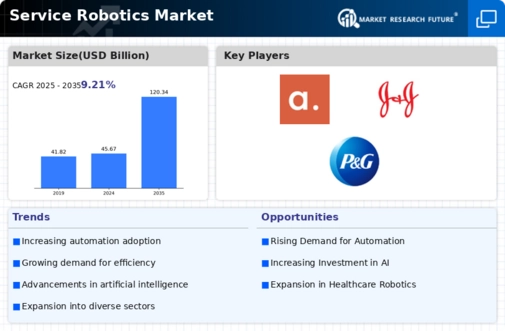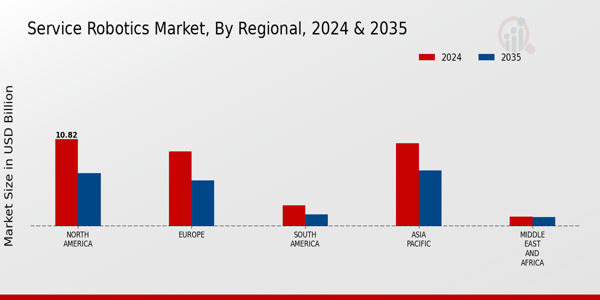Market Analysis
Service Robotics Market (Global, 2024)
Introduction
The service robots market is set for a major transformation, with technological developments and an increasing demand for automation reshaping industries. Service robots, designed to assist humans in various tasks from caregiving and hospitality to logistics and agriculture, are becoming an indispensable part of the business processes and customer experience. As companies seek new solutions to the labour shortage and to enhance the customer experience, the market for service robots is set to accelerate. This report provides an overview of the current state of the service robots market and examines the key drivers, challenges and emerging trends influencing this market.
PESTLE Analysis
- Political
- In 2024, governments are increasingly supportive of the service robot market. More than thirty countries have enacted regulations promoting the use of robots in various sectors. For example, the European Union has allocated a budget of one and a half billion dollars to develop robots for the purpose of improving automation in health care and industry. In the United States, tax incentives have been established for companies that invest in robots. The government has also set aside $500 million for small and medium-sized enterprises to adopt robots.
- Economic
- Economic factors affecting the market for service robots are labour costs and the cost of automation. In the United States, the average hourly wage for service workers is projected to reach $20.50 by 2024, and this will prompt companies to adopt automation in order to control operating costs. The total amount invested in robots is expected to reach $12.5 billion. The amount of venture capital invested in robot companies is expected to rise to $3 billion this year. In this economic environment, it is expected that companies will adopt automation to improve efficiency and reduce labour costs.
- Social
- The social acceptance of robots is growing. In the West, according to a recent survey, more than sixty-five percent of consumers are willing to have robots in public places like restaurants and hotels. Besides the increased familiarity with the technology, people are also aware of the benefits of improved service quality. In addition, the aging of the population is creating a demand for robots in the health care field. By 2030, it is estimated that about twenty percent of the population in developed countries will be over sixty-five years old, and this will increase the demand for robots in the caregiving sector.
- Technological
- The service robots market is driven by technological advances. The investment in artificial intelligence is expected to reach $500 billion in 2024. Machine learning and computer vision are enabling robots to perform more complex tasks more precisely and with greater speed. Furthermore, the integration of 5G is expected to increase the functionality and interactivity of service robots. By 2024, there are expected to be a billion 5G connections worldwide, which will allow real-time data processing and communication.
- Legal
- The law relating to robots is developing, and legislation is being enacted in fifteen countries to regulate the liability and safety of service robots. In 2024, new guidelines for the safe use of service robots will be published by the International Organization for Standardization, with an impact on both manufacturers and service suppliers. Furthermore, the stricter data protection legislation that has been enacted, such as the General Data Protection Regulation (GDPR) in Europe, which imposes a fine of up to 20 million euros for non-compliance, will affect how service robots handle personal data.
- Environmental
- The environment is becoming a key concern for service robots, with an estimated 30% of companies in the field of robots to commit themselves to sustainable initiatives by 2024. Energy-saving robots consume up to 40% less power than conventional models. Also, the use of recycled materials is increasing, and it is expected that by 2025, one-quarter of all new service robots will be made from recycled materials, demonstrating the growing importance of reducing the carbon footprint of the robot industry.
Porter's Five Forces
- Threat of New Entrants
- The market for service robots in 2024 is characterized by moderate entry barriers. The initial investment and the required knowledge can be a deterrent for newcomers, but the growing demand for automation and the technological progress that makes it possible to do so attract both newcomers and established companies. There are, however, strong brands with a good market position and customer loyalty that pose a challenge to newcomers.
- Bargaining Power of Suppliers
- The bargaining power of suppliers in the market for service robots is relatively low. The parts necessary for the construction of service robots, such as sensors, software and hardware, are obtainable from many different suppliers. This gives the suppliers a relatively low level of power, as the companies can easily turn to other suppliers if necessary. Furthermore, the increasing trend towards vertical integration among the manufacturers reduces the suppliers’ power even further.
- Bargaining Power of Buyers
- The buyers of service robots have a considerable bargaining power because of the increasing number of products available. There are more and more companies and the technical possibilities are growing, which means that the customer has a wide choice of products and services. Competition makes the manufacturers compete with regard to price, quality and service, which gives the buyer a certain bargaining power.
- Threat of Substitutes
- The threat of substitution in the market for service robots is moderate. While there are some alternatives to automation, such as human labor or simpler automation, the unique capabilities and efficiencies of advanced service robots make them the preferred choice in many applications. However, as technology evolves, the threat of substitution may rise, posing a risk to market participants.
- Competitive Rivalry
- Competition in the service robot market is intense, driven by the rapid technological development and a growing number of players. Companies are constantly innovating to establish a competitive advantage and win market share. This leads to a number of aggressive marketing strategies, price wars and continuous product development. It is a challenging environment for all market participants.
SWOT Analysis
Strengths
- Rapid advancements in AI and machine learning enhancing robotic capabilities.
- Increased demand for automation in various sectors such as healthcare, manufacturing, and logistics.
- Cost reduction in production and maintenance of service robots due to technological improvements.
Weaknesses
- High initial investment costs for businesses adopting service robotics.
- Limited public acceptance and trust in robotic systems.
- Potential job displacement concerns leading to resistance from workforce.
Opportunities
- Expansion into emerging markets with growing industrial sectors.
- Development of specialized robots for niche applications, such as elderly care and hospitality.
- Collaborations with tech companies to integrate IoT and smart technologies into service robots.
Threats
- Intense competition from both established players and new entrants in the robotics field.
- Regulatory challenges and safety concerns regarding the deployment of service robots.
- Economic downturns that may lead to reduced investment in automation technologies.
Summary
Service robots are characterized by the main advantages such as technological advancements and increasing demand from various industries. High costs and public skepticism are the main weaknesses. Opportunities are emerging markets and niche applications, and threats are competition and legal issues. Strategic innovation and addressing public concerns will be essential for all actors in this developing area.






Leave a Comment